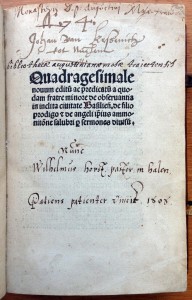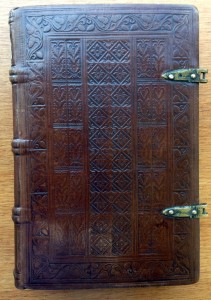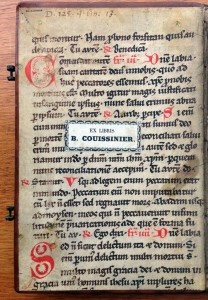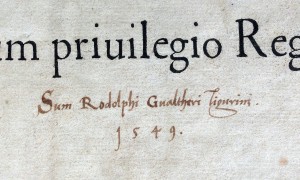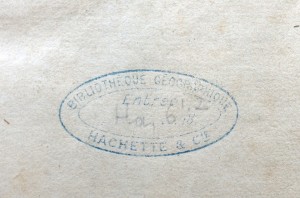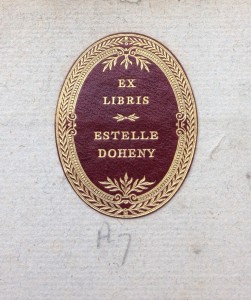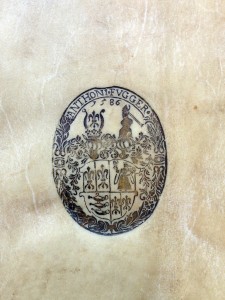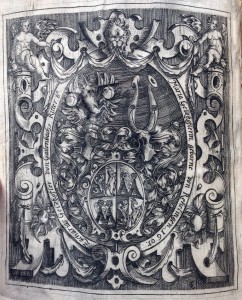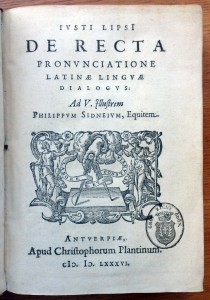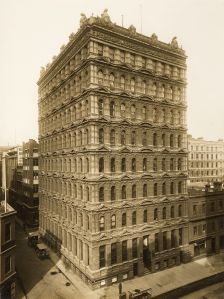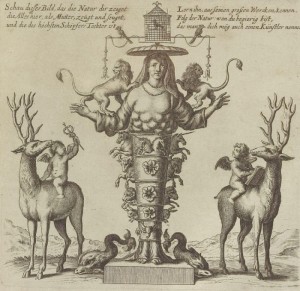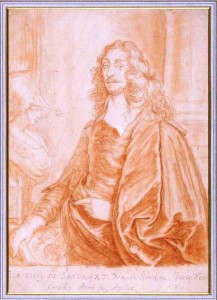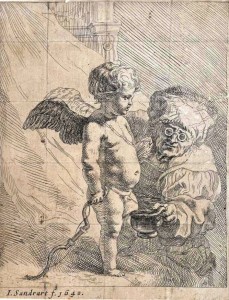Provenance in Pictures: Tracking the Ownership of Three Early Printed Books
Last week a group of Melbourne bibliophiles were treated to a delightful talk by preeminent bookman Nicolas Barker, editor of The Book Collector, and whose bibliography records an impressive 1,000+ entries.[1]
Barker examined twenty or so works from Special Collections and talked to the salient points of each book. This post highlights three of the selected items that had multiple signs of ownership, all of which caught Barker’s eye.
Johannes Meder, Quadragesimale de filio prodigo et de angeli ipsius ammonitione salubri per sermones diuisum [Basel: Michael Furter, 1495].
Judging by the number of inscriptions on the title-page, this copy of Meder’s Quadragesimale certainly travelled, but not very far. All of them can be localised to the province of Limburg in the Netherlands. The earliest is the inscription by Johan van Kessenich, shown above in between two other inscriptions towards the head of the title-page. Kessenich was born ca. 1522, served as steward of the Augustinian cloister of St Elisabeth in Nunhem, and died ca. 1608. The book then passed to a Wilhelm Horst, whose tidy inscription notes that he was a pastor in the town of Haelen (just 1km south of Nunhem), and came into possession of the Quadragesimale the same year as Kessenich’s approximate date of death. The last two pieces of evidence recorded on the title-page puts the book in the library of the Augustijnenkerk (Church of the Augustinians) in Maastricht, about 55km southwest of Haelen.
The book was bound in a contemporary style by the twentieth-century French binder Roger Devauchelle (1915-1993), who preserved the original clasp catches, the paper spine label, and presumably the pastedowns: two fragments (according to the catalogue entry) from a thirteenth-century manuscript.
Affixed to the front pastedown is the book label of ‘B. Couissinier’, and Devauchelle’s stamp can be found in the upper-left corner.[2]
Purchased by the Friends of the Baillieu Library with funds from the George Shaw Trust.
Eusebius Pamphilus, [Greek title:] Evangelicae praeparatio lib. XV … [with] Evangelicae demonstrationis lib. X. Paris: Robert Estienne, 1544-1545.
The earliest sign of ownership on Estienne’s 1544 edition of Eusebius is an inscription dated just five years after its publication. It reads: ‘Sum Rodolphi Gualtheri Tigurini 1549’. The owner, Rudolf Gwalther (1519-1586), was a Reformed Protestant pastor in Zurich (‘Tigurum’) who married the daughter of Huldrych Zwingli (1484-1531), one of the leaders of the Reformation in Switzerland. He became head of the Zurich church upon the death of Zwingli’s successor Heinrich Bullinger (1504-1575).
The book can next be placed in another Zurich collection, the ‘Bibliothecae Heideggeriana’. This collection was formed by Hans Heinrich Heidegger (1711-1763), whose son, Johann Heinrich (1738-1823), continued to expand the library. A slip pasted on the front free endpaper with the date ‘1783’ written upon it suggests the Eusebius was acquired by the younger Heidegger that year. The Heideggeriana collection was sold in 1810 when Johann moved to Geneva.[3]
Sometime after the Heidegger sale, the Eusebius made its way to France and into the stock of the great bookshop and publishing house L. Hachette et Compagnie, whose acquisition stamp on the title-page dates to 1918.
The volume next appeared in the library of Estelle Doheny (1875-1958), who amassed one of the great twentieth-century book collections in America. Doheny left her library, which included a volume of the Gutenberg Bible, to St John’s Seminary in Camarillo, California.[4] In her bequest, Doheny stipulated that the collection must be kept together for 25 years after her death. In 1986, the Archdiocese of Los Angeles and the Seminary Board of Directors made the controversial decision to sell the Doheny collection. The books were auctioned by Christie’s, New York, in a series of sales held between 1987 and 1989. The Eusebius was sold to Parsons Books in the 1 February 1988 sale (lot 559).[5]
Purchased by the Ivy M. Pendlebury bequest in memory of Gerald Frederic Pendlebury.
De recta pronunciatione Latinae linguae dialogus. Antwerp: Christophe Plantin, 1586.
This copy of Plantin’s 1586 edition of Lipsius has a long connection to families that wielded financial power. The first being the stamp of Anton Fugger dated 1586. He was a member of a wealthy German banking and merchant family, their financial prospects secured by his namesake, Anton Fugger (1493-1560), whose trade empire extended to the Americas and the West Indies, and who also held mining interests in Scandinavia.
This beautifully engraved bookplate is the most physically impressive piece of provenance evidence found among these three books. Measuring 17 x 14 cm, the ex libris belonged to Zacharias Geizkofler von Gailenbach (1560-1617), who had his name and that of his wife, Maria (nee von Rehelingen), along with her date of birth, engraved along the central oval frame. From 1597, Geizkofler served as Reichspfennigmeister (treasurer) of the Holy Roman Empire, and as an adviser to the emperors Rudolf II (1552-1612) and Matthias (1557-1619).
The Lipsius eventually travelled to what was Austria-Hungary. There it came into the possession of the noble Magyar family, Zichy, though which family member has yet to be confirmed. The title-page is stamped with the arms and name of Count Ödön Zichy. This may refer to Count Ödön (1809-1848), a governmental administrator who was executed as a result of a court martial, or Count Ödön (1811-1894), founder of the Oriental Museum in Vienna and a great patron of art and industry.
The second Hungarian collector to own this book was Jan Szasz, about whom I have been able to find very little.[6] It appears, however, that Szasz might have immigrated to the Antipodes, for a number of books with his bookplate are found in Australian institutional and private libraries.
Purchased by the Ivy M. Pendlebury bequest in memory of Gerald Frederic Pendlebury.
Anthony Tedeschi (Deputy Curator, Special Collections)
—
[1] See A.S.G. Edwards, Nicolas Barker at Eighty: A List of His Publications to Mark His 80th Birthday (New Castle, DE; London: Oak Knoll Press; Bernard Quaritch Ltd., 2013).
[2] Do you recognise the ‘B. Couissinier’ bookplate? If you know who he or she was, please leave a comment or email me at Special Collections.
[3] Selecta artis typographicae monumenta e bibliotheca Heideggeriana sive Catalogus librorum seculo XV impressorum … qui pro adjectis in margine pretiis publica auctionis lege divenduntur d. 18. Jun… (Zurich, 1810)
[4] The Gutenberg Bible volume was purchased by the Maruzen Co. of Tokyo for USD $5.3m (with premium) in the 22 October 1987 sale (lot 1). It was acquired by Keio University Library in March 1996.
[5] The Estelle Doheny Collection … Part III: Printed Books and Manuscripts including Western Americana (New York: Christie, Manson & Woods, 1988) 173 (lot 559)
[6] As with the book label of M. or Mme Couissinier, I would welcome any information on this collector named Szasz.
